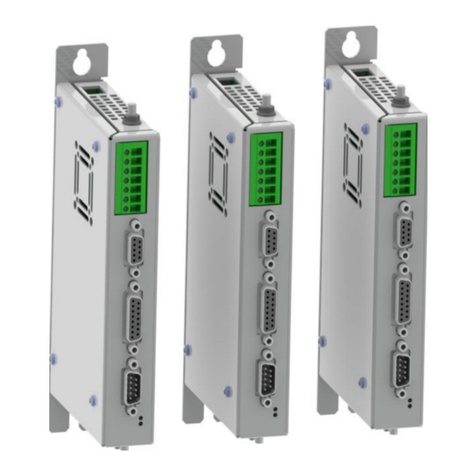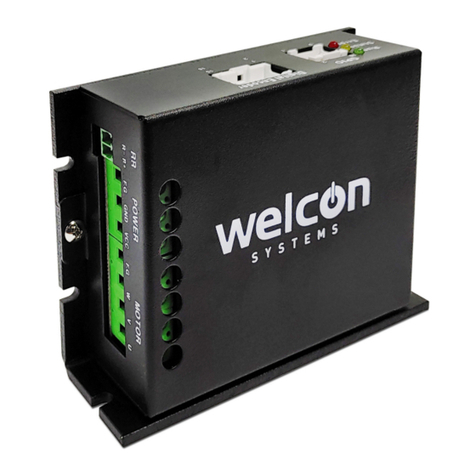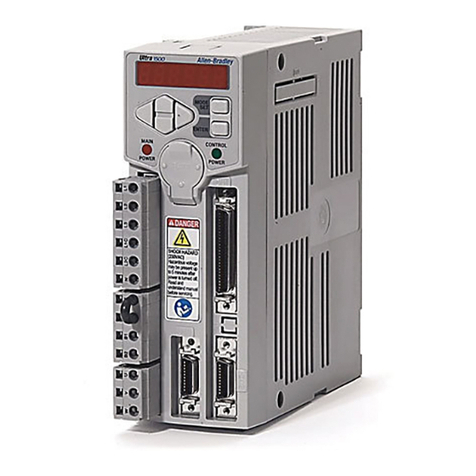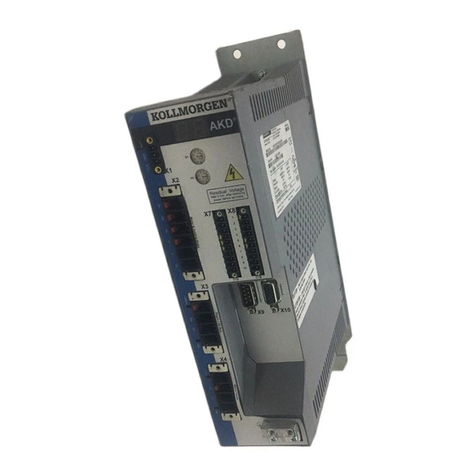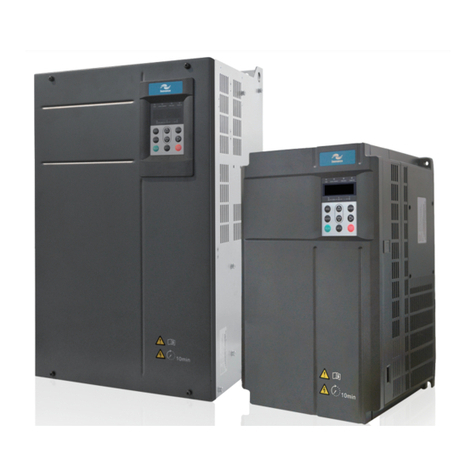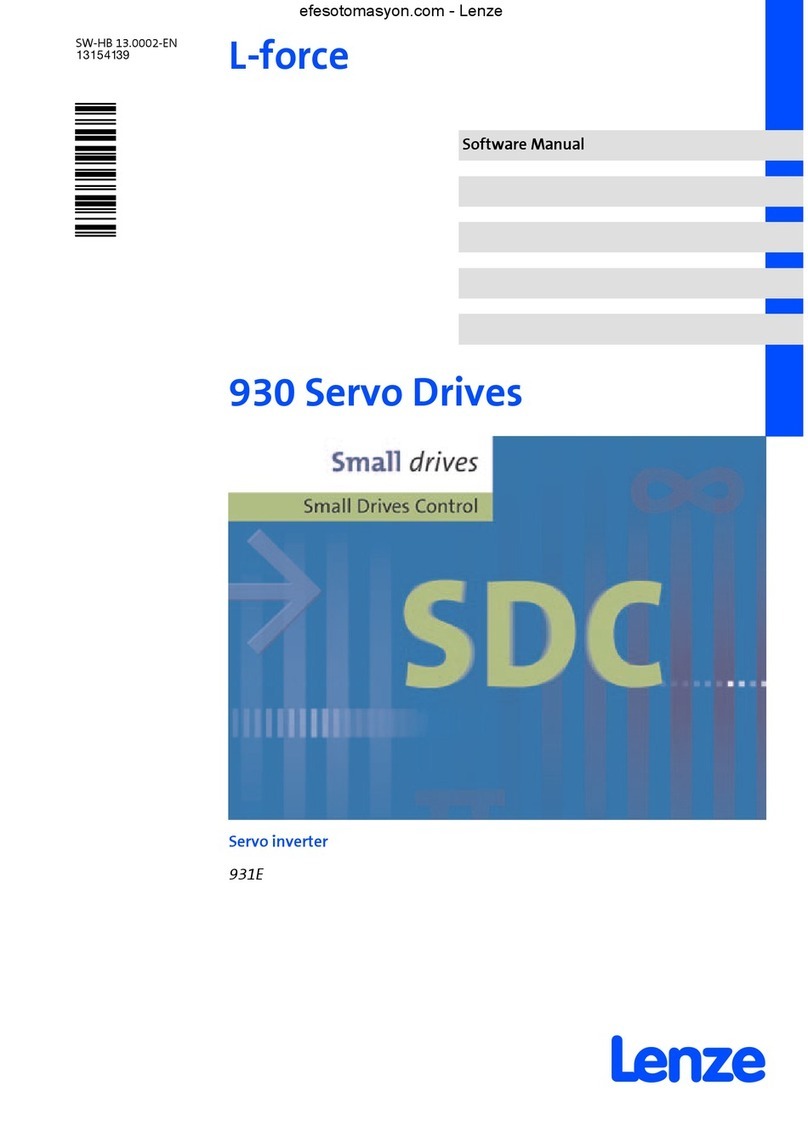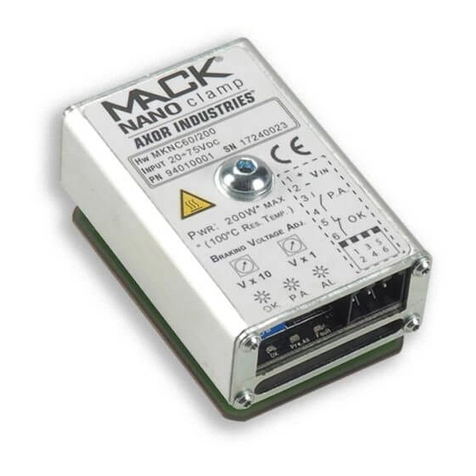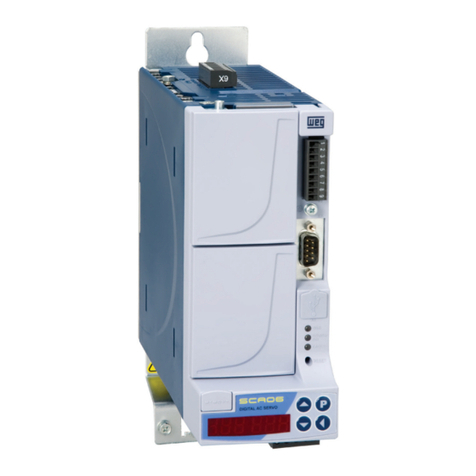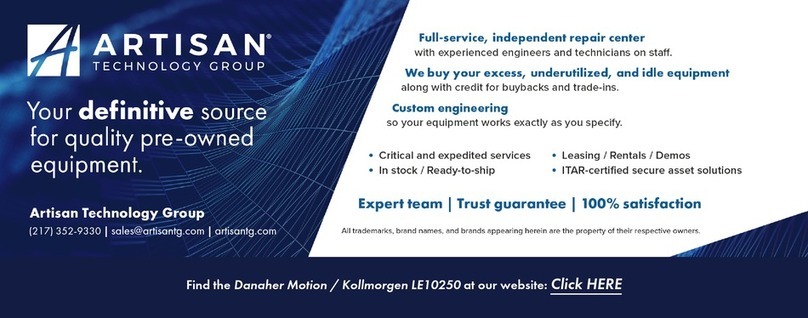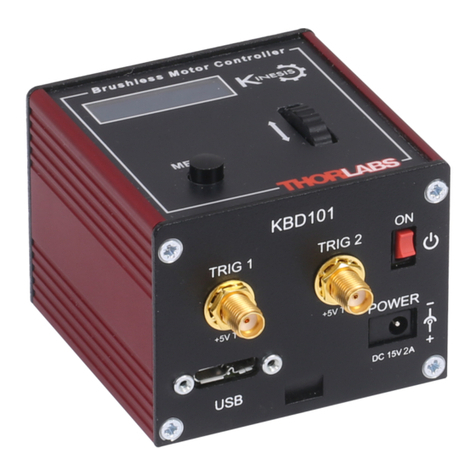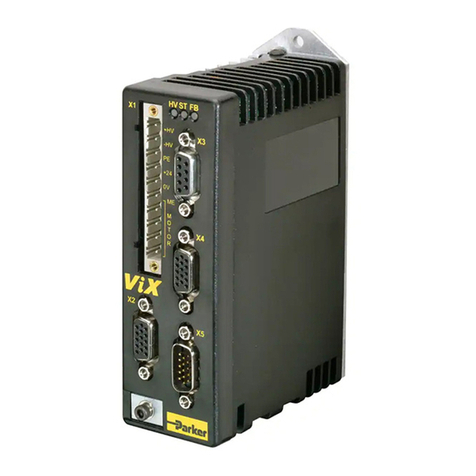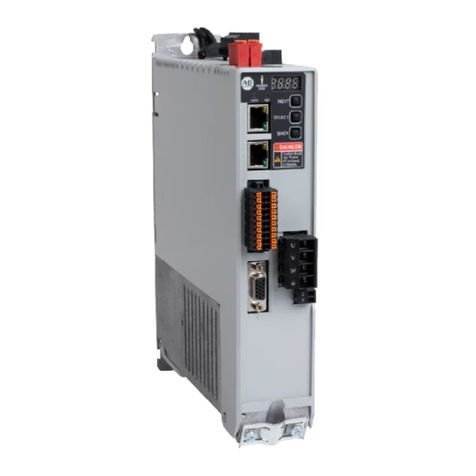AutomationDirect SureServo2 User manual

110/220 VAC Drives
Quick Start Guide
High Resolution Communication Type AC Servo Drive
(1) General precautions
Thank you for purchasing this product. This instruction sheet provides information about the SV2A series servo drives
and servo motors. Before using this product, read this instruction sheet carefully to ensure the correct use of the
product. Keep this sheet handy for quick reference whenever needed. Before you begin, please note the following:
◼The installation location must be free of vapor, corrosive and flammable gas.
◼When wiring, do not connect the three-phase power supply to the motor UVW connectors. Incorrect wiring may
cause damage to the servo drive.
◼Ensure this product is correctly grounded. All grounding and circuit protection methods must comply with all local
standards/regulations and the national electrical standard (refer to NFPA 70: National Electrical Code, 2020 Ed.).
◼Do not disassemble the servo drive and motor or change the wiring when the power is on.
◼Ensure you can activate the STO circuit before the servo drive is connected to power and put into operation.
◼Do not touch the heat sink of the servo drive when it is connected to power and operating to avoid scalding.
For more information about the SV2A series servo drives and servo motors, refer to the user manual. Contact our
Technical Support Department if you encounter any problems.
(1) Précautions générales
Merci d’avoir acheté ce produit. Cette feuille d’instructions fournit des renseignements sur les entraînements et les
moteurs asservis de la série SV2A. Avant d’utiliser ce produit, lisez attentivement ce feuillet d’instructions pour vous
assurer d’utiliser correctement le produit. Gardez cette feuille à portée de la main pour consultation rapide, au besoin.
Avant de terminer la lecture de cette feuille, suivez les instructions suivantes :
◼L’emplacement de l’installation doit être exempt de vapeurs ou de gaz corrosifs ou flammables.
◼Lors du câblage, ne connectez pas l’alimentation triphasée aux connecteurs UVW du moteur. Un mauvais câblage
peut endommager l’entraînement asservi.
◼Assurez-vous que ce produit est correctement mis à la terre. La méthode de mise à la terre et protection des
circuits doit être conforme à la norme électrique nationale (voir NFPA 70 : National Electrical Code, édition 2020).
◼Ne démontez pas l’entraînement ou le moteur asservi et ne modifiez pas le câblage lorsque l’alimentation est sous
tension.
◼Assurez-vous de pouvoir activer l’arrêt d’urgence avant que l’entraînement asservi ne soit connecté à l’alimentation
et mis en marche.
◼Ne touchez pas le dissipateur thermique de l’entraînement asservi lorsqu’il est branché à l’alimentation et qu’il
fonctionne pour éviter l’échaudement.
Pour en savoir plus sur les entraînements et les moteurs asservis de la série SV2A, consultez le manuel d’utilisation. En
cas de problème, communiquez avec notre Centre de service à la clientèle.
(2) Safety precautions
The SV2A series is a high-resolution servo drive used in industrial applications. Install it in a shielded control box
before operation. Install the servo drives, wires, and motors in an environment that complies with the minimum
requirement of UL50 Type 1 or NEMA 250 Type 1.
Pay special attention to the following safety precautions during inspection, installation, wiring, operation, maintenance,
and examination.
Inspection
➢Follow the instructions when using the servo drive and servo motor to avoid risk of fire or malfunction.
Installation
➢Do not expose the product to an environment containing vapor, corrosive gas, flammable gas, or other
foreign matter to reduce the risk of electric shock or fire.
Wiring
➢Connect the ground terminals to a Class 3 ground system. Ground resistance should not exceed 100Ω.
Improper grounding may result in electric shock or fire.
➢Do not connect three-phase power to motor output terminals U, V and W. Doing so may cause personnel
injury or fire.
➢Tighten the screws on the power and motor output terminals to ensure good connections and avoid risk of
fire.
➢When wiring, refer to the descriptions of the wire selection to prevent any danger.
Operation
➢Before operating the machine, change the parameter settings according to the application. If the parameters
are not adjusted to the correct values, it may lead to machine malfunctions or unpredictable operation.
➢Before the machine starts to operate, make sure you can activate the STO circuit at any time.
➢Do not touch any rotating motor parts during operation, or it may result in personnel injury.
➢During the first test run, remove all units (including the couplings and belts) and operate the machine without
any load to avoid accidents.
➢Improper machine operation after the servo motor connects may damage the machine and lead to personnel
injury.
➢In order to prevent danger, make sure the servo motor can operate normally without load. Then try operating
the motor with load.
➢Do not touch the heat sink of the servo drive during operation to avoid scalding.
Maintenance and inspection
➢Do not touch the internal parts of the servo drive or servo motor, as that may cause electric shock.
➢Do not disassemble the servo drive panel when the power is on, as that may cause electric shock.
➢Do not touch the wiring terminals within 10 minutes after turning off the power, as doing so creates a risk of
electric shock from residual voltage.
➢Do not disassemble the servo motor, as that may cause electric shock or personnel injury.
➢Do not change the wiring when the power is on, as that may cause electric shock or personnel injury.
➢Only qualified electricians can install, wire, repair, and maintain the servo drive and servo motor.
➢Make sure that the "CHARGE" indicator is off before performing maintenance, inspection, or repair.
Main circuit wiring
➢Do not repeatedly turn the power on and off. If power cycling is needed, wait one minute between cycles.
➢Do not put the power cable and signal cable in the same channel or bond them together. Separate the power
cable and signal cable by at least 30cm (11.8 in.).
➢Use stranded wires and multi-core shielded-pair wires for the encoder cables. The maximum length should
be no more than 20m (65.6 ft).
➢High voltage may remain in the servo drive after the power is turned off. Wait for 10 minutes before touching
the terminals and make sure the “CHARGE” indicator is off before performing inspection.
Terminal wiring of the main circuit
➢When wiring, remove the terminal blocks from the servo drive.
➢Insert only one electric wire per terminal socket.
➢When inserting the electric wires, do not short-circuit the core wire with adjacent wires.
➢Before applying power, inspect and make sure the wiring is correct.
(2) Précautions de sécurité
Comme la série SV2A est un entraînement asservi à haute résolution de type ouvert utilisé dans les applications
industrielles, installez-le dans une boîte de contrôle blindée. Installez les entraînements asservis, les fils et les moteurs
dans un environnement conforme aux exigences minimales des normes UL50 Type 1 ou NEMA 250 Type 1.
Portez une attention particulière aux précautions de sécurité suivantes pendant l’inspection, l’installation, le câblage,
l’utilisation, l’entretien et l’examen.
Inspection
➢Suivez les instructions lors de l’utilisation de l’entraînement et du moteur asservis afin d’éviter un incendie ou le
dysfonctionnement.
Installation
➢N’exposez pas le produit à un environnement contenant des vapeurs, du gaz corrosif ou flammable ou d’autres
corps étrangers afin réduire le risque de choc électrique ou d’incendie.
Câblage
➢Raccordez les bornes de mise à la terre à un système de mise à la terre de classe 3. La résistance de terre ne
doit pas dépasser 100 Ω. Une mise à la terre inadéquate peut provoquer un choc électrique ou un incendie.
➢Ne connectez pas l’alimentation triphasée aux bornes de sortie du moteur U, V et W afin d’éviter les blessures
corporelles ou un incendie.
➢Serrez les vis des bornes d’alimentation et de sortie du moteur afin d’éviter un incendie.
➢Lors du câblage, reportez-vous aux descriptions de sélection des fils afin d’éviter tout danger.
Utilisation
➢Avant d’utiliser la machine, modifiez les paramètres en fonction de l’application. Si les paramètres ne sont pas
réglés aux valeurs correctes, cela peut entraîner un dysfonctionnement de la machine ou le fonctionnement
incontrôlé.
➢Avant de mettre la machine en marche, assurez-vous de pouvoir activer l’arrêt d’urgence en tout temps.
➢Ne touchez aucune pièce rotative du moteur pendant qu’il fonctionne, car cela peut entraîner des blessures
corporelles.
➢Afin d’éviter les accidents lors du premier essai de fonctionnement, retirez tous les accessoires, y compris les
accouplements et les courroies, afin que la machine fonctionne à vide.
➢Si vous ne faites pas fonctionner la machine correctement après la connexion du moteur asservi à la machine,
cela pourrait causer des dommages à la machine et des blessures au personnel.
➢Afin de prévenir le danger, assurez-vous que le moteur asservi fonctionne normalement à vide. Essayez ensuite
de faire fonctionner le moteur sous charge.
➢Ne touchez pas le dissipateur thermique de l’entraînement asservi lorsqu’il fonctionne pour éviter
l’échaudement.
Entretien et inspection
➢Ne touchez pas les pièces internes de l’entraînement et du moteur asservis, car cela peut causer un choc
électrique.
➢Ne démontez pas le panneau de l’entraînement asservi lorsque l’alimentation est sous tension, car cela peut
provoquer un choc électrique.
➢Ne touchez pas les bornes de câblage dans les 10 minutes après avoir coupé l’alimentation, car la tension
résiduelle peut provoquer un choc électrique.
➢Ne démontez pas le moteur asservi, car il peut causer un choc électrique ou des blessures corporelles.
➢Ne modifiez pas le câblage lorsque l’alimentation est sous tension, car elle peut causer un choc électrique ou
des blessures corporelles.
➢Seuls les électriciens qualifiés peuvent installer, raccorder, réparer et entretenir l’entraînement et le moteur
asservis.
➢Assurez-vous que l’indicateur « CHARGE » est éteint avant d’effectuer l’entretien, l’inspection ou la réparation.
Câblage du circuit principal
➢Ne mettez pas l’appareil sous tension et hors tension à plusieurs reprises. Si une mise sous tension et hors
tension continue est nécessaire, attendez un intervalle d’une minute.
➢Ne mettez pas le câble d’alimentation et le câble de signal dans le même conduit et ne les liez pas. Séparez le
câble d’alimentation et le câble de signal d’au moins 30 centimètres (11,8 pouces).
➢Utilisez des paires de fils torsadés et de fils multicœurs blindés pour les câbles de l’encodeur. La longueur
maximale ne doit pas dépasser 20 mètres (65,6 pieds).
➢Une tension élevée peut rester dans l’entraînement asservi une fois l’alimentation désactivée. Attendez
10 minutes avant de toucher les bornes et assurez-vous que l’indicateur « CHARGE » est éteint avant
d’effectuer l’inspection.
Câblage des bornes du circuit principal
➢Lors du câblage, retirez les borniers de l’entraînement asservi.
➢Insérez un seul fil électrique par douille de borne.
➢Lors de l’insertion des fils électriques, ne court-circuitez pas le fil central avec des fils adjacents.
➢Avant d’appliquer l’alimentation, inspectez le câblage et assurez-vous qu’il est correct.
(3) Wire selection
The following wire sizes and circuit protection (High-Speed J fuses or circuit breakers) are recommended for connection
to SV2A drives. Standard 60˚C copper wire values used for calculations. See the SureServo2 User Manual for more
details.
Always follow all local and national electrical codes when selecting wiring and circuit protection.
Servo drive
model
L1C L2C
RST
P1 P2
P3 C
UVW (motor)
Wire Size
mm2
(AWG)
Fusing
Voltage Level
Wire Size
mm2(AWG)
Circuit
Protection
(A)
Wire Size
mm2(AWG)
Wire Size
mm2(AWG)
Wire Size
mm2(AWG)
SV2A-2040
0.8
(18AWG)
5A breaker
6A fuse
110-120 VAC 1-phase
1.3 (16AWG)
8
0.8 (18AWG)
0.8 (18AWG)
0.8 (18AWG)
200-230 VAC 1-phase
1.3 (16AWG)
10
200-230 VAC 3-phase
1.3 (16AWG)
5
SV2A-2075
110-120 VAC 1-phase
2.1 (14AWG)
15
0.8 (18AWG)
0.8 (18AWG)
0.8 (18AWG)
200-230 VAC 1-phase
3.3 (12AWG)
16
200-230 VAC 3-phase
2.1 (14AWG)
10
SV2A-2150
110-120 VAC 1-phase
3.3 (12AWG)1
201
1.3 (16AWG)
0.8 (18AWG)
3.3 (12AWG)
200-230 VAC 1-phase
3.3 (12AWG)1
201
200-230 VAC 3-phase
2.1 (14AWG)
15
SV2A-2200
110-120 VAC 1-phase
5.3 (10AWG)1
301
2.1 (14AWG)
1.3 (16AWG)
3.3 (12AWG)
200-230 VAC 1-phase
5.3 (10AWG)1
301
200-230 VAC 3-phase
3.3 (12AWG)
20
SV2A-2300
200-230 VAC 3-phase
5.3 (10AWG)
30
2.1 (14AWG)
2.1 (14AWG)
3.3 (12AWG)
SV2A-2550
200-230 VAC 3-phase
8.4 (8AWG)1
401
5.3 (10AWG)
3.3 (12AWG)
13.3 (6AWG)
SV2A-2750
200-230 VAC 3-phase
8.4 (8AWG)1
401
8.4 (8AWG)
3.3 (12AWG)
13.3 (6AWG)
SV2A-21F0
2.1
(14AWG)1
200-230 VAC 3-phase
21.2 (4AWG)1
701
13.3 (6AWG)
8.4 (8AWG)
21.2 (4AWG)
Note:
1. Wire size (and circuit protection) limited by physical size of connectors. See the User Manual for details on higher
amperages.
Servo Drive Model
L1C, L2C, R, S, T
Locking Torque
(kgf•cm)
Bare Wire Length
(mm)
SV2A-2550
17.85
12–13
SV2A-2750
16
10–11
SV2A-21F0
31.62
12–13
No doubling
Doubling
Servo drive
Encoder wiring - wire diameter mm² (AWG)
Size
Number
Specification
Standard length
SV2A
L = 3-20 m: 0.324 mm²-2C (22AWG-2C)
+ 0.205 mm²-2P (24AWG-2P)
2C + 2P
L = 3 - 20 m
(UL2464)
L = 3 - 20 m
(9.84 - 65.6 ft)
Note: when the encoder cable length is 3 - 20 m, AWG22 is +5V and grounded, and AWG24 is the signal cable.
(4) Ambient installation conditions
Ambient environmental conditions for installing and operating the SV2A servo drive:
The environment should be free of devices that generate excessive heat; no water, vapor, dust, or oily
dust; no corrosive and flammable gas or liquids; no airborne dust or metal particles; the environment
should be solid without vibration and free from electromagnetic noise.
Ambient environmental conditions when operating the servo motor:
Operating environment ambient temperature should be between 0°C (32°F) and 40°C (104°F). The
environment should be free of devices that generate excessive heat; no water, vapor, dust, or oily dust; no
corrosive and flammable gas or liquids; no airborne dust or metal particles.
(4) Conditions ambiantes d’installation
Conditions ambiantes d’installation et d’utilisation de l’entraînement asservi SV2A :
L’environnement doit être exempt d’appareils qui génèrent une chaleur excessive; pas d’eau, de
vapeurs, de poussière et de poussière huileuse; aucun gaz ou liquide corrosif et flammable; pas de
poussière ou de particules métalliques en suspension dans l’air; l’environnement doit être exempt de
vibrations et de bruit électromagnétique.
Conditions ambiantes de fonctionnement du moteur asservi :
La température ambiante de l’environnement de fonctionnement doit être entre 0 °C (32 °F) et 40 °C
(104 °F). L’environnement doit être exempt d’appareils qui génèrent une chaleur excessive; pas d’eau,
de vapeurs, de poussière et de poussière huileuse; aucun gaz ou liquide corrosif et flammable; pas de
poussière ou de particules métalliques en suspension dans l’air.

Air Flow Measuring Points
When operating the servo drive, the ambient environmental temperature should be between 0°C (32°F) and 55°C (131°F). If
the temperature is over 45°C (113°F), place the product in a well-ventilated environment. During long-term operation, the
suggested temperature of the operating environment should be under 45°C (113°F) to ensure the servo drive’ s
performance. For SV2A-2040, keep a clearance of at least 50mm above the drives and keep the speed of air flow above 0.5
m/s. For SV2A-2075, SV2A-2150, SV2A-2200, SV2A-2300, SV2A-2550, SV2A-2750, and SV2A-2F00, keep a clearance
of at least 50mm above the drives and keep the speed of air flow above 1 m/s. If the product is installed in an electrical
cabinet, make sure the size of the cabinet and its ventilation condition can prevent the internal electrical devices from
overheating. Also, check if the vibration of the machine affects the electrical devices in the electrical cabinet.
La température ambiante de l’environnement de fonctionnement de l’entraînement asservi doit être entre 0 °C (32 °F) et
55 °C (131 °F). Si la température est supérieure à 45 °C (113 °F), placez le produit dans un environnement bien ventilé.
Pour le fonctionnement à long terme, la température suggérée de l’environnement d’opération doit être inférieure à 45 °C
(113 °F) afin d’assurer le bon rendement de l’entraînement asservi. Si le produit est installé dans un tableau de distribution,
assurez-vous que la taille du tableau de distribution et la ventilation peuvent empêcher la surchauffe des dispositifs
électriques internes. Vérifiez également si la vibration de la machine affecte les dispositifs électriques du tableau de
distribution.
(5) Installation direction and space
Precautions:
◼Incorrect installation direction may result in malfunction.
◼For better ventilation and cooling, allow sufficient clearance space between the AC servo drive and the adjacent
objects and the wall, or overheating may result in malfunction of the machine.
◼Do not block the ventilation holes of the AC servo drive, and do not mount it in the incorrect direction, or it may
result in malfunction of the machine.
(5) Orientation et espace requis pour l’installation
Precautions:
◼Une mauvaise orientation d’installation peut entraîner un dysfonctionnement.
◼Pour une meilleure ventilation et un meilleur refroidissement, prévoyez un dégagement suffisant entre
l’entraînement asservi c.a., les objets adjacents et le mur, sinon la surchauffe peut entraîner un
dysfonctionnement de la machine.
◼Ne bloquez pas les orifices d’aération de l’entraînement asservi c.a. et ne le fixez pas dans la mauvaise direction,
ou cela pourrait entraîner un dysfonctionnement de la machine.
Correct
Incorrect
Installation: In order to have adequate air flow for ventilation, follow the suggested clearances as shown in the following
diagram when installing one or more servo drives.
One servo drive
Multiple servo drives
Note: The above diagrams are not accurately scaled. Refer to the annotations on the diagrams.
Servo drive model
Cooling method
Minimum distance (d) corresponding to
the operating temperature (Ta)
*Considering the assembly tolerances, the servo drive requires
a minimum clearance of 1mm
SV2A-2040
Natural cooling
SV2A-2075
SV2A-2150
SV2A-2200
SV2A-2300
SV2A-2550
SV2A-2750
SV2A-2F00
Natural cooling plus
forced cooling
(6) Basic inspection
Item
Description
General inspection
◼Periodically check to confirm the screws are securely tightened. This includes the screws in
the servo drive, the connection screws between the motor shaft and machine, and the
connection screws between the terminal block and machine.
◼Prevent oil, water, metallic particles, and other foreign matter from entering the control box or
ventilation equipment. Protect the servo drive from any drill cuttings.
◼If the control box is installed in a location where dust or harmful gas are present, ensure the
dust or harmful gas cannot enter the control box.
◼Make sure to wire encoders and other devices in the proper sequence to avoid sudden
unintended acceleration or damage to the motor.
Inspection before
operation
(power is not
applied)
◼To avoid electric shock, connect the ground terminal of the servo drive to the ground terminal
of the control box. If wiring must be added or modified, wait at least 10 minutes after
disconnecting the servo drive from the power supply or discharge the electricity with a
discharge device.
◼Isolate the wires at the wiring terminal.
◼Make sure the wiring is correct to avoid damage or any abnormal operation.
◼Check for and remove any electrically conductive objects, including metal sheet and screws,
or flammable objects inside or near the servo drive.
◼Make sure the STO circuit is OFF.
◼To ensure the electromagnetic brake works, make sure the stop and circuit breaker functions
are working properly.
◼Reduce the electromagnetic interference if there is electromagnetic interference with the
peripheral devices.
◼Make sure the external voltage level of the servo drive is correct.
Inspection before
operation
(power is applied)
◼The encoder cable should be protected from excessive stress – make sure the cable is not
worn or stretched.
◼Contact AutomationDirect if the servo motor vibrates or makes unusual noise during operation.
◼Make sure the parameter settings are correct. Different machines have different
characteristics. Adjust the parameters according to the characteristics of each machine.
◼Reset the parameters when the servo drive is in the Servo Off status to avoid possible
malfunction.
◼If there is no contact noise or other abnormal noise when the relay is operating, contact
AutomationDirect
◼Contact AutomationDirect if the power indicator or LED display does not function properly.
(7) Wiring
Single-phase power supply (models of 2 kW and
below can use 110VAC or 220VAC single phase)
Three-phase power supply (220VAC for all series)
Servo drive
L1C
L2C
R
S
T
Noise filter
Motor
MC SPD
ALRM_RY_B
Power 1 Power 2 MC
RS
24 VDC
DO5+ (28)
CN1
U
V
W
MCCB
MC
DO5- (27)
ALRM_RY
P1
P2
Servo drive
L1C
L2C
R
S
T
Noise filter
Motor
MC SPD
ALRM_RY_B
Power 1 Power 2 MC
RS
24 VDC
DO5+ (28)
CN1
U
V
W
MCCB
MC
DO5- (27)
ALRM_RY
T
P1
P2
Note: MCCB: molded case circuit breaker; MC: magnetic contactor; SPD: surge protection device; Power 1: power on;
Power 2: power off; ALRM_RY: alarm relay; ALRM_RY_B: normally closed contact of the alarm relay
(8) Wiring diagram for the servo system
DI9-
13
15
11
9
10
34
8
33
32
18
19
16
30
31
7
6
5
4
3
2
1
26
28
40
CN1
P3
D
C
U
V
W
R
S
T
SON
CCLR
TCM0
TCM1
ARST
NL
PL
OVRD
1.5KΩ
1.5KΩ
1.5KΩ
1.5KΩ
1.5KΩ
SRDY
ZSPD
TPOS
HOME
ALRM
24V
10KΩ
10KΩ
Twisted-pair
or twisted-
shielde d cable
10KΩ
±10V
Regenerative
resistor
Red
White
Black
Green Brake
Motor
supply
Encoder
24V
*2
*2
4.7 KΩ
4.7 KΩ
KΩ
KΩ
29
DI10 38
27
46
1.5KΩ
P1
P2
*3
4.7
4.7
KΩ
4.7
KΩ
4.7
KΩ
4.7
KΩ
4.7
KΩ
4.7
KΩ
4.7
SG Twisted-pair or
twisted-
shielde d cable
T-REF
GND
MON1
GND
MON2
COM+
DI1-
DI2-
DI3-
DI4-
DI5-
DI6-
DI7-
DI8-
DO1+
DO1-
DO2+
DO2-
DO3+
DO3-
DO4+
DO4-
DO5+
DO6-
DO5-
DO6+
-1
-2
STO_A 3
/STO_A 4
STO_B 5
/STO_B 6
FDBK+ 7
FDBK- 8
CN10
STO
GND
OCZ 44
48
OA
/OA
OB
/OB
OZ
/OZ
21
22
50
24
25
23
Max. output current: 50mA
Max. voltage: 30V
A phase pulse
B phase pulse
Zphase pulse
Z phase open
collector
Encoder
pulseoutput
CN3
CN4
CN5+5V
Opt A
Opt /A
Opt B
Opt /B
Opt Z
GND
GND
Opt /Z
9
1
2
3
5
6
7
8
4
-
-
-
13
12
10
11 -
-
-
14
15
Mini USB
T+
T-
Shielding
5
6
Case
CN2+5V
GND
1
2
-
-
RS485+
RS485-
GND_ISO
-
6,8
5
4
3,7
2
1
OVRD
BRKR
L1C
L2C
ESTOP
24Vdc
Safety
relay
DOX-
Servo drive
DOX+
Make sure the
polarity of diode is
correct, or it may
damage the servo
drive.
24Vdc
Digital Output Rating:
Max 30VDC, Max 40mA
For inductive loads, usea diode
Digital Input Rating:
ON: 15 - 24VDC, 8mA
OFF: <5VDC, <0.5 mA
42
44
10KΩ
±10VV-REF
GND
Noise filter
MC SPD
ALRM_RY_B
Motor
Power
ON
Motor
Power
OFF MC
RS
MCCB
T
37
36
41
43
Pulse input
(Line Driver) /PULSE
PULSE
SIGN
/SIGN
SIGN
/SIGN
12KΩ
1.2KΩ
12KΩ
1.2KΩ
*1
Use a current limiting
resistor if necessary
24V Open-collector pulse command input
PULL HI_P 39
37
41/PULSE
SIGN
/SIGN
SG
PNP type equipment PULL HI_S 35
DC
24V
+
-
PULL HI_P 39
37
41/PULSE
SIGN
/SIGN
SG
NPN type equipment PULL HI_S 35
DC
24V
+
-
Inputs SIGN(36) and PULSE (43) are
designed for Line Driver (differential)
signals. Do not use with 24V. For 5V
open collector applications, see
section 3.5 in the User Manual.
Note: *1. For 200-230VAC single-phase input or 100-120VAC single-phase input (≤ 2kW), use R and S.
*2. To use external regen resistors: Connect resistors across terminals P3 and C and remove jumper between P3
and D.
To use the internal regen resistor (≤ 3kW): Jumper terminals P3 and D.
(Drives > 3kW do not have an internal regen resistor.)
*3. The brake coil has no polarity. (BRKR = DO code 08 and OVRD = DI code 21)
(see the other diagrams for clearance dimensions)

(9) Dimensions and weight of servo drive
SV2A-2040 model
SV2A-2075, SV2A-2150 models
180(7.1)
70(2.8)
5.5(0.22)
50(2)
36.3(1.43)
2.1(0.08) 180(7.2)
172.5(6.9)
M5*0.8
M5*0.8
160(6.3)
50(2)
180(7.2)
Unit: mm (inch)
Mounting
dimensions
Weight
1.3 kg (2.87 lb)
SV2A-2200, SV2A-2300 models
Weight
2.7 kg (5.94 lb)
SV2A-2550 model
Weight
5.5 kg (12.13 lb)
SV2A-2750 model
Weight
7.5 kg (16.53 lb)
SV2A-2F00 model
Weight
15 kg (33.07 lb)
Note: the values displayed in the above figures are measured in metric units. The values displayed in imperial units are
for reference only.
(10)Circuit Protection (maximum allowable values)
Servo drive
model
Main Voltage Level
Drive
Rated
Input
Circuit
breaker
Fuse
Fuse Class
SV2A-2040
100-120VAC 1-phase
200-230VAC 1-phase
3.98 A
4.69 A
10A
15A
Class CC
200-230VAC 3-phase
2.76 A
10A
10A
SV2A-2075
100-120VAC 1-phase
200-230VAC 1-phase
7.73 A
8.71 A
20A
20A
200-230VAC 3-phase
5.09 A
13A
15A
SV2A-2150
100-120VAC 1-phase
200-230VAC 1-phase
12.56 A
14.82 A
30A
30A
200-230VAC 3-phase
8.09 A
20A
25A
SV2A-2200
100-120VAC 1-phase
200-230VAC 1-phase
18.03 A
20.83 A
40A
40A
Class J
Or
High Speed J*
200-230VAC 3-phase
11.36 A
30A
35A
SV2A-2300
200-230VAC 3-phase
14.52 A
35A
50A
SV2A-2550
200-230VAC 3-phase
27.06 A
60A
70A
SV2A-2750
200-230VAC 3-phase
37.33 A
70A
80A
SV2A-2F00
200-230VAC 3-phase
69.95 A
120A
125A
* Edison JHL fuses
These circuit protection values are the maximum values allowed by UL. See section 3) Wire Selection
for recommended wire and circuit protection values. Always follow all local and national electrical codes
when selecting circuit protection.
Separate fuses/breakers can be used for the control circuit. Install two fuses or a double pole breaker if
the control power will be using two phases of a 3-phase system. Due to inrush, each drive control circuit
should have separate circuit protection (don’t supply two drives with one breaker).
Control Power
Circuit breaker
Class CC Fuse
All models
5A
6A
(11) Quick Start Guide
This section will show how to safely and quickly start up a SureServo2 (SS2) drive. Wiring and starting
up the drive should only be performed by a qualified professional. High voltage levels are in use.
Commissioning is quicker and easier using the drive configuration software SV2-PRO, but the entire
start-up procedure can be accomplished with the keypad (detailed here). For further information and
more complete startup instructions, please download the SureServo2 User Manual (SS2 UM) from
www.automationdirect.com. Be sure to visit www.automationdirect.com/videos for helpful videos covering
SureServo2 commissioning, programming, and operation.
Preliminary Wiring
To safely and quickly start up a SureServo2 (SS2) drive, several different types of wiring need to be
verified first. Until this wiring and functionality is verified, it is highly recommended to NOT connect main
incoming power (R,S,T) or connect the load to the motor shaft.
1. Connect the ground wires to the screws at the bottom of the drive. Connect the incoming
ground to one screw and connect the motor ground to the other screw. (The motor ground
wire is in the motor cable SV2C-Pxxx-xxxx.)
2. Connect the wiring for L1C and L2C (single phase 100-120VAC or 200-230VAC). This is
control power and should be continuously available (not disconnected with E-stop, etc.).
3. Connect an appropriate safety circuit to CN10. See the wiring diagram elsewhere in this
document or the SureServo2 User Manual. Although the CN10 connector comes pre-wired
with an STO bypass, it is strongly recommended to wire a safety relay to connect STO_A to
/STO_A and to connect STO_B to /STO_B.
4. Connect the motor encoder cable (SV2C-Exxx-xxxx) to the motor and to CN2 of the drive.
5. Connect the appropriate 24VDC input devices to DI1-DI10. Pay close attention to these
Digital Input (DI) definitions. Their default (out-of-the-box) configurations are listed below.
DI1 = Servo On input (wired normally open)
DI5 = Alarm Reset (wired normally open)
DI6 and DI7 = Overtravel inputs. Inputs are wired normally closed (in a fail-safe manner).
If the application is rotary and has no overtravel inputs, these inputs can be temporarily
wired to DC common (0 volts) or disabled thru programming (procedure shown below).
DI8 =Override (temporary Motor Stop input wired normally closed). NOTE: The STO input
(CN10) is separate from the Override (temporary Motor Stop input wired normally closed)
input DI8.
Weight
0.92 kg (2.02 lb)

Apply Control Power and Reset to Factory Defaults
Once the preliminary wiring previously described is complete, control power can be applied to the servo.
Apply 110VAC or 220VAC power to L1C and L2C (the actual connector on small drives may be labeled
“L1” and “L2”); and apply 24VDC to the I/O (CN1 connector).
To ensure that the drive has all default settings, reset the drive. To do this, enter a value of 10 into
P2.008. On the drive’s keypad:
[These are the general instructions on how to set any Parameter address value]
1. Press M to enter Parameter Mode. (Press M until
you see a parameter address that begins with P,
like P0.000.)
2. Press ◄ to advance to the P2 group
3. Press ▲ or ▼ to advance to P2.008
4. Press S to enter P2.008 and see the current value
5. Press ▲ or ▼ to change the value to 10
6. Press S to set the value.
7. The drive will display SAVED, BUSY, then DONE.
Cycle power to the drive. The drive will now
contain all factory default settings.
Clear the Alarms
The drive will power up with alarms. The most common alarms are listed below with the most common
solutions. For more detailed information and all possible alarm codes, search for the alarm code (ALxxx)
in the SS2 UM.
Display
Alarm Name
Solution (see the UM for more details)
AL500
STO Enabled
Enable the safety circuit to connect the STO signals (CN10). When the
safety circuit is enabled, this alarm can be cleared. Reset with DI5
Alarm Reset. For temporary testing without a load attached to the
motor, the supplied jumpers on the CN10 connector can bypass the
STO feature.
AL501
AL502
AL503
STO Errors
These alarms occur when the STO inputs are not simultaneously
active/inactive. Ensure proper wiring and activation of the safety circuit.
Reset by cycling power to the drive.
AL003
Undervoltage
This alarm occurs when the main motor power (R,S,T) is not present
and the Servo On input (DI1) is ON. At this point of commissioning,
ensure that R,S, and T do NOT have power and that DI1 is OFF.
Reset this alarm with DI5 Alarm Reset.
AL011
Encoder error
Ensure the encoder is connected. Verify the wiring on CN2. Ensure the
motor ground and drive ground are properly connected. Reset by
cycling drive power.
AL013
Motor Override
Ensure that DI8 Motor Override is ON (DI8 is configured Normally
Closed as default). ON = current flowing = no fault.
AL014
AL015
Overtravel
Limit
Ensure that DI6 and DI7 are ON or redefine the inputs (see below).
These inputs are defined Normally Closed as default. ON = current
flowing = no fault.
Change the Digital Input Definition
If the application does not call for Overtravel limits, the definitions of DI6 and DI7 can be changed so that
alarms AL014 and AL015 are not active. To disable DI6 and DI7 by changing parameters through the
keypad, perform the following keystrokes:
1. Press M to enter Parameter Mode. (Press M until you
see a parameter address that begins with P, like
P0.000.)
2. Press ◄ to advance to the P2 group
3. Press ▲ or ▼ to advance to P2.015 (DI6 functional
planning)
4. Press S to enter P2.015 and see the current value
(default = 022 = Negative overtravel)
5. Press ▲ or ▼ to change the value to 000 to disable
the input
Note: ◄ moves the cursor left one digit (required for
some parameter entry)
6. Press S to set the value.
7. Repeat the procedure to disable P2.016 (DI7) if desired.
Digital
Input
Input Def.
Parameter
Default Definition (hex
values)
Notes (corresponding Alarm)
Necessary for
startup
DI1
P2.010
0101 = Servo On
Enables the servo
Yes
DI2
P2.011
0104 = Clear Pulses
Clears accumulated input pulses
No
DI3
P2.012
0116 = Torque Cmd 0
Torque Select Bit 0 (when in
No
Torque mode)
DI4
P2.013
0117 = Torque Cmd 1
Torque Select Bit 1 (when in
Torque mode)
No
DI5
P2.014
0102 = Alarm Reset
Clears alarms
Yes
DI6
P2.015
0022 = CW Overtravel
Disables motion in CW direction
(AL014)
Yes (or disable
to clear alarms)
DI7
P2.016
0023 = CCW Overtravel
Disables motion in CCW
direction (AL015)
Yes (or disable
to clear alarms)
DI8
P2.017
0021 = Motor Override
Stops motor immediately.
(AL013). Motor can restart when
this DI is switched OFF
Yes
DI9
P2.036
0100 = Disabled
Defined as Disabled and
Normally Open
No
DI10
P2.037
0100 = Disabled
Defined as Disabled and
Normally Open
No
NOTE: Setting the least two digits of P2.010 – P2.037 to 00 disables the input.
The third digit signifies Normally Open or Normally Closed.
Input Definitions with 1xx are Normally Open. DI is ON when current is flowing thru the terminals.
Definitions with 0xx are Normally Closed. DI is ON when current is NOT flowing thru the terminals.
(It is recommended to set disabled inputs to 100, so the logic states are OFF when not energized.)
Verify Encoder Feedback
On the keypad, press M to cycle the display off of Parameter addresses (P2.015, etc.) or any active
alarms (AL500, etc.). The display will now show Drive Status. Press ▲ or ▼ until Fb.PUU is displayed.
After 1 second, the drive will display the Feedback Pulses in User Units. Rotate the shaft manually
clockwise. The display should increment from 0-99,999 for one motor rotation. Decimal points beside the
4th and 5th digits indicate a negative position. This is a quick indication of which side of absolute zero the
motor feedback is on. If an encoder alarm or unexpected feedback is seen, check all encoder cabling
from the drive’s CN2 to the motor. Check for loose connections or crossed wiring. See the UM for more
help.
Verify Digital Inputs
Set P0.002 to 39 to display the DI status (in hex format) on the drive’s LED display. As long as energizing
the input does not trigger an alarm, the LED display will report the Digital Input status in hex. If an input
does trigger an alarm (example: if DI8 is set for Motor Override and the input is ON), AL.xxx overrides the
DI display (AL013 = Motor Override). Press M to cycle the LED back to the DI status display.
If the Digital Input is defined as Normally Closed (the function code is 0xx), the input will be considered
active (ON) if there is no current flowing thru the terminal. Note: inputs defined as 000 are disabled, but
are considered ON (Normally Closed) if there is no current flowing thru the terminals. To redefine the
inputs, see Change the Digital Input Definition section above.
If this is the only input
that is ON
This is the LED display (data
in hex) when P0.002 = 39
Data in binary (DI1 =
bit 0, DI2 = bit 1, etc.)
DI1
L0001
0000 0000 0000 0001
DI2
L0002
0000 0000 0000 0010
DI3
L0004
0000 0000 0000 0100
DI4
L0008
0000 0000 0000 1000
DI5
L0010
0000 0000 0001 0000
DI6
L0020
0000 0000 0010 0000
DI7
L0040
0000 0000 0100 0000
DI8
L0080
0000 0000 1000 0000
DI9
L0100
0000 0001 0000 0000
DI10
L0200
0000 0010 0000 0000
If multiple inputs are ON at the same time, add the above results.
If these inputs are ON
LED display (P0.002 = 39)
Data in binary
DI1 and DI2
L0003
0000 0000 0000 0011
DI4 and DI5
L0018
0000 0000 0001 1000
Verify Digital Outputs (DOs)
The Digital Outputs can be forced ON without requiring the corresponding DO function to be active. To
put the outputs into Diagnostic Mode, set P2.008 to the value 406. Select the Digital Outputs to force ON
and OFF by setting the hex value in P4.006. Each DO is forced ON by the corresponding bit set in
P4.006. (DO1 = bit 0, DO2 = bit 1, etc.). Press ◄ to move the cursor left one digit. Press S to set (apply)
the force to the outputs.
To force this output ON
Set this value in P4.006
Data in binary
DO1
0001
0000 0001
DO2
0002
0000 0010
DO3
0004
0000 0100
DO4
0008
0000 1000
DO5
0010
0001 0000
DO6
0020
0010 0000
Multiple outputs can be forced ON at the same time. Examples:
DO1 + DO2
0003
0000 0011
All (DO1-DO6)
003F
0011 1111
Once DO testing/verification is complete, exit DO Diagnostic Mode by cycling control power to the drive.
Connect Motor Power and Spin the Motor (w/o load)
NOTE: It is highly recommended to not connect the motor to the load before verifying proper motor
operation. When first spinning the motor, the shaft should not be connected to anything.
1. Connect a motor power cable to the motor and drive (Ground=green, U=red, V=white,
W=black).
2. Re-verify incoming control power (L1C, L2C), DI/DO wiring (including 24VDC power), and STO
wiring (CN10).
3. Ensure that the Servo ON input (DI1) is not ON.
4. If using a brake motor, connect 24VDC to the brake wires to release the brake. Polarity is not
important.
5. Connect incoming main power to the drive (Ground, R,S,T).
6. If any alarms are present, correct the alarms (refer to the explanation above for common
alarms, refer to the UM for more information).
The drive can be jogged from the keypad to verify operation.
7. Enable the Servo ON input with DI1. The motor should lock into position.
8. Refer back to Step #4. It is embarrassing if you forget to release the brake.
9. Set the desired Jog Speed in P4.005 (or press S to accept the default 20rpm in P4.005):
The display will now display -JOG-
NOTE: If the display shows SV-On, enable Servo ON with DI1 and repeat Step 9
10. Use ▲ and ▼ to jog the motor forward and reverse.
Press M to change speed.
Cycle the drive’s control power to exit Jog Mode.
NOTE: the display will not annunciate alarms while in Jog Mode.
Once the motor successfully jogs, the motor, feedback, and drive have been shown to be properly
installed. The system can now be programmed and commissioned along with the control system.
There are tables at the beginning of Parameters Chapter 8 that detail the most common parameters
used for the different drive control modes:
PT Mode: Position control – Terminals (high speed pulse input commands)
PR mode: Position control – Registers (point-to-point moves using internal registers for setpoints)
This mode includes point to point moves, registration, and camming
S Modes: Speed/Velocity control
S = analog input speed command
Sz = internal speed registers that include a zero-speed setting
T modes: Torque control
T = analog input torque command
Tz = internal torque registers that include a zero-torque setting
Firmware Upgrade
Occasionally, there will be new servo drive firmware to add new features or correct problems. Go to
http://www.automationdirect.com and search for your servo drive part number. On that part number's
item page you will find a link for the latest SureServo2 firmware. Compare the website’s current firmware
version to P0.000 (firmware version) and P5.000 (firmware sub-version) in the servo drive. If the versions
match, your drive has the latest firmware. If the online version is higher than P0.000, download the
firmware file from automationdirect.com. Next, open SureServo2 Pro software and connect to the drive.
Then select "Burn" from the pull-down menus to update your drive's firmware. Please see the
SureServo2 Pro help file for detailed instructions and more information.
Other manuals for SureServo2
2
This manual suits for next models
8
Popular Servo Drive manuals by other brands

Pilz
Pilz PMCtendo DD5 operating manual
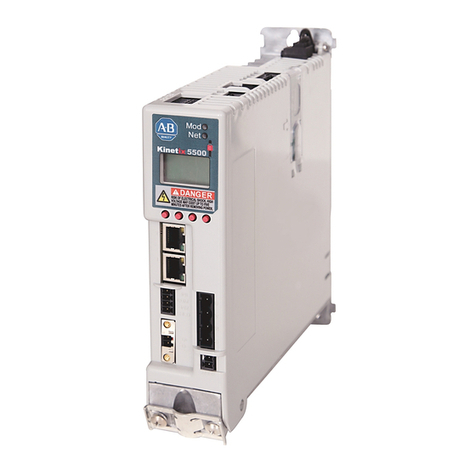
Rockwell Automation
Rockwell Automation Allen-Bradley Kinetix 5500 installation instructions

Mannesmann Rexroth
Mannesmann Rexroth DDS 2.1 Applications manual
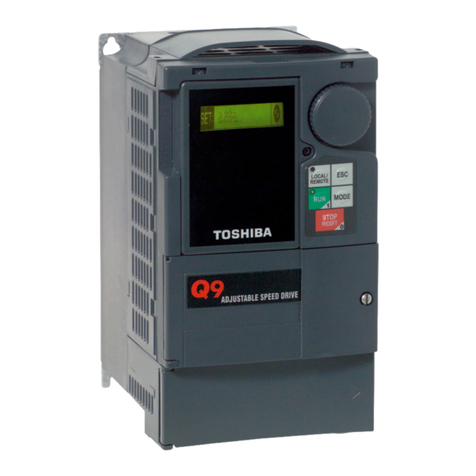
Toshiba
Toshiba Q9 Series Installation and operation manual
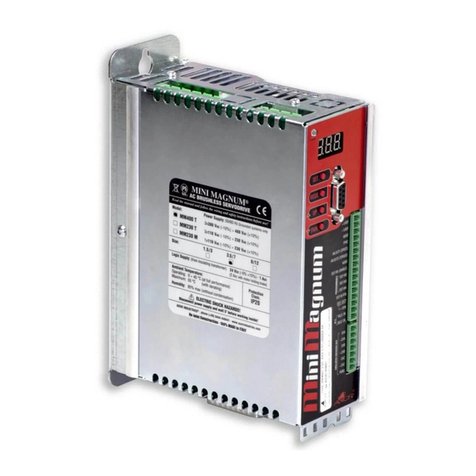
AXOR Industries
AXOR Industries MiniMagnum Series Service manual

Danaher Motion
Danaher Motion S200-CNS Hardware installation manual
